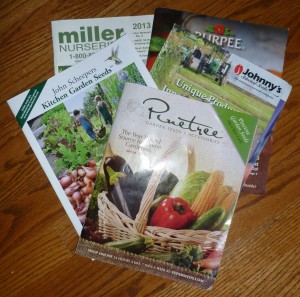How to Read a Seed Catalog
If you have ever ordered anything even remotely horticultural through the mail, or if you subscribe to even one gardening magazine, it’s likely that the postman has already delivered a large stack of seed catalogs to your home. (And, if he hasn’t, don’t despair, they are all available on line.)
In my home, more than half the catalogs, filled with luscious photos and adjective-laden descriptions designed to seduce, are discarded the day they arrive. I believe a good seed catalog begins with useful basic gardening advice at the beginning of each vegetable variety. That information is critical for the novice and a good reminder for even the most advanced gardener.
 Further, I prefer to order from New England based catalog companies. Their seeds are chosen to grow in our climate while the large national companies have to have varieties for the entire country, and sometimes it can be hard to discern if a plant is best suited to Mississippi or Massachusetts.
Further, I prefer to order from New England based catalog companies. Their seeds are chosen to grow in our climate while the large national companies have to have varieties for the entire country, and sometimes it can be hard to discern if a plant is best suited to Mississippi or Massachusetts.
Let’s read a seed catalog together, starting with the one fruit everyone wants to grow: the tomato. Which of the hundreds of available varieties should we grow? Take a careful look at the descriptions of each cultivar. By parsing the descriptions, you can find the varieties that best meet your needs.
Here’s a sample description from the Pinetree Seed catalog: Sun Gold tomato (F1 hybrid 60 days). From those few words you know that it is not an heirloom but, rather, comes from two parents. The fruit will ripen approximately 60 days from transplanting it into the garden.
The description goes on to say Indeterminate which means the vine keeps growing as long as the weather allows and will keep setting fruit. Determinate tomatoes stop growing at a predetermined height and produce all their fruit at one time.
The description continues: Great tomatoey flavor, an 8 on the brix scale. Fruits are 1” round globes which turn an attractive golden orange when ripe. Translation: it’s sweet, it tastes like a tomato (some don’t), it is small, and don’t pick it till it’s orange. Productive vines provide very high yields It will produce a lot of fruit.
On another page the Pinetree Seed catalog has this listing: Grandeur tomato (F1 75days) VFN&T. Translation: it’s another hybrid, you’ll have harvestable fruit 75 days from transplanting and the cultivar has been bred to have natural resistance to vercillium, fusarium, tobacco mosaic and root knot nematode – four nasty diseases that affect tomatoes. An early red cluster tomato with 5-7 fruits per bunch, 6-9oz. firm, meaty tomatoes. Now we know it’s a medium size red tomato growing in clusters. A vigorous grower, long yielding with large leaves that help with resistance to cracking. There’s a caution here: a ‘vigorous grower’ means that the tomato vine will need a sturdy support and ‘long yielding’ means it won’t stop producing early. ‘Cracking’ is the blemish that occurs while the fruit grows, more important perhaps to the farmer than at home.
Next we go to Johnny’s Seeds to find different zucchini to compare. Dunja (F1) OG 47days (PM,PRV,WMV,ZM) is a hybrid with two non-hybrid parents, it has been organically produced, and will have fruit 47 days from planting the seed. It is resistant to powdery mildew, papaya ringspot virus, watermelon mosaic virus and zucchini mosaic virus.
Dunja is a high yielder of dark green, straight zucchinis. Well that’s easy to understand. Open plants and small spines make for an easy harvest. The squash will be easy to spot and won’t scratch your hands, too much.
Costata Romano HL 52 days Traditional Italian heirloom with the best flavor. Distinctive zucchini are gray-green, green flecks and prominent ribs. These are heirloom zucchini with a unusual look. Big, large-leafed plants with about half the yield of hybrids but much better tasting; clearly better texture, nutty and delicious, raw or cooked. Compared to the Dunja, this is one grown for flavor, not a huge crop.
By carefully reading the descriptions, mentally removing most of the adjectives, and thinking about what you like and need, you can winnow the hundreds of varieties of each vegetable down to just the few that suit you and your family. Just remember to keep the size of your garden in mind when you find that your list of “perfect for you” vegetables is two pages long!